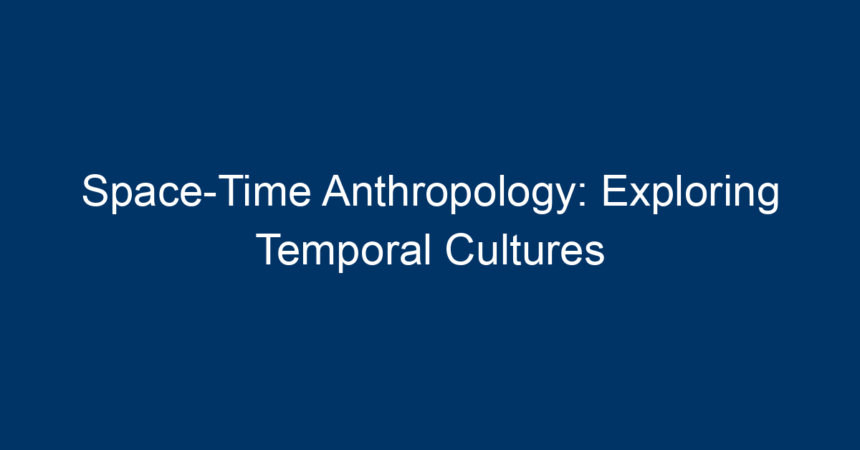Introduction
In the vast tapestry of human existence, time and space are woven intricately together, shaping our cultures, relationships, and worldviews. Space-time anthropology emerges as a captivating field of study, illuminating how different societies perceive and conceptualize time and space. This article delves into the principles of space-time anthropology, its relevance in contemporary society, and how various cultures experience the passage of time uniquely.
Understanding Space-Time Anthropology
What is Space-Time Anthropology?
Space-time anthropology is an interdisciplinary approach that investigates how various cultures understand and experience time and space. It considers the geographical, historical, and social contexts that influence these perceptions. By integrating theories from sociology, psychology, and geography, space-time anthropology uncovers the profound impact of temporality on human behaviors and interactions.
Theoretical Foundations
At its core, space-time anthropology is built upon several key theories:
-
Chronotope: Introduced by Mikhail Bakhtin, the concept of chronotope refers to the intrinsic connection between temporal and spatial relationships in narratives and social practices.
-
Cultural Relativity: This principle asserts that concepts of time and space are not universal but are shaped by cultural contexts. For instance, Western linear time contrasts sharply with many Indigenous cultures’ cyclical notions of existence.
- Temporal Locus: This aspect focuses on how different societies prioritize the past, present, or future, influencing their customs, rituals, and societal structures.
Temporal Cultures Around the World
The Linear Time Perspective
Primarily found in Western societies, the linear time perspective views time as a continuous progression from past to present to future. Key characteristics include:
- Goal Orientation: In cultures with a linear view of time, individuals often set goals and work towards future achievements.
- Chronological Planning: Schedules, calendars, and deadlines are essential in organizing daily life and activities.
Examples: In the United States and much of Europe, people celebrate milestones like birthdays, graduations, and anniversaries, marking them as significant points along a timeline.
The Cyclical Time Perspective
Conversely, many Indigenous cultures adopt a cyclical view of time. Key features include:
- Ritualistic Importance: Cyclical cultures emphasize the importance of rituals that align with natural cycles, such as the seasons or lunar phases.
- Community and Connection: Time is often seen as a connected continuum, reinforcing community bonds and intergenerational relationships.
Examples: Native American cultures often celebrate seasonal cycles with rituals that honor nature and its rhythms, emphasizing harmony rather than individual achievement.
A Flexible Approach to Time
Some Southeast Asian cultures present a more fluid understanding of time, characterized by a flexible approach to scheduling and punctuality. Key aspects include:
- Present-Mindedness: Emphasis on mindfulness and being present in the moment, rather than adhering strictly to schedules.
- Relational Focus: The value placed on relationships and social harmony can take precedence over rigid time structures.
Examples: In cultures like those in Thailand, flexibility in time can sometimes lead to misunderstandings with individuals from more linear time cultures, where punctuality is integral.
The Intersection of Space and Time
Geographic Influences on Temporal Experiences
The relationship between space and time plays a crucial role in shaping cultural perceptions. Geographic factors influence how people interact with their environment and experience time:
-
Urban vs. Rural Settings: Urban dwellers often adhere to strict timelines due to the fast-paced nature of city life, whereas rural communities may experience time more leisurely, influenced by agricultural cycles.
- Cultural Landscapes: Spaces of significance, such as sacred sites, can alter temporal perceptions, creating a sense of timelessness and community belonging.
Modernization and Temporal Shifts
As globalization accelerates, space-time anthropology examines how these changes affect cultural perceptions of time:
-
Technological Impacts: Advancements in technology have created a "real-time" culture where immediacy and instant communication alter traditional temporal practices.
- Cultural Crossover: Increased interactions among diverse cultures can lead to hybrid notions of time, combining elements of linear and cyclical perspectives.
Practical Implications of Space-Time Anthropology
Navigating Cultural Differences
Understanding space-time anthropology is increasingly vital in our interconnected world. Here are actionable insights for individuals and organizations:
-
Cultural Sensitivity Training: Equip employees with knowledge about different temporal cultures to enhance workplace communication and collaboration, especially in global teams.
-
Adaptation in Business Practices: When negotiating or conducting business internationally, recognize and respect varying time perceptions to foster trust and mutual respect.
- Community Engagement: In social work and community development, consider the unique temporal frameworks of populations to create programs aligned with their values and practices.
Enhancing Personal Relationships
In interpersonal relationships, space-time anthropology can enhance understanding and connection:
-
Discussing Time Preferences: When forming personal relationships, openly discuss and acknowledge each other’s views on time, especially in cross-cultural contexts.
- Rituals and Celebrations: Participate in the rituals and celebrations that reflect a partner’s cultural understanding of time, fostering shared experiences and deeper connections.
Conclusion
Space-time anthropology offers rich insights into the temporal cultures that shape our lives. By exploring the intricate relationship between time and culture, we can nurture understanding, foster empathy, and create more cohesive communities. Whether in our personal relationships or professional interactions, recognizing and respecting diverse temporal perspectives can bridge cultural divides and enhance our global society.
Actionable Insights
- Educate yourself and others about different cultural perceptions of time.
- Embrace flexibility and adaptability in your schedules, especially with international collaborations.
- Engage in community discussions that celebrate cultural diversity, emphasizing the importance of time and space in various traditions.
As we continue to explore the dynamics of space-time anthropology, we pave the way for a more inclusive and understanding world.




